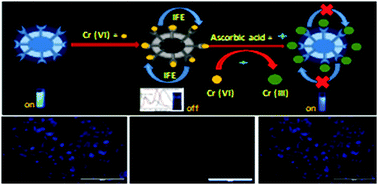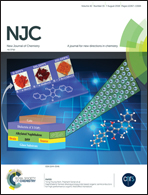Bright-blue-emission nitrogen and phosphorus-doped carbon quantum dots as a promising nanoprobe for detection of Cr(vi) and ascorbic acid in pure aqueous solution and in living cells†
Abstract
Highly fluorescent nitrogen and phosphorus-doped carbon quantum dots (N,P-CQDs) were synthesized via a one-step hydrothermal method and fully characterized via various techniques such as TEM, DLS, FT-IR, P-XRD and XPS analysis. The as-synthesized N,P-CQDs showed excellent optical properties and exhibited bright blue colour under UV-light with CIE coordinate (0.20, 0.22) along with a high quantum yield of 73%, due to which they could act as on–off fluorescent nanoprobes for the selective and sensitive detection of highly toxic Cr(VI) below its permissible limit via the inner filter effect (IFE) and static quenching mechanism. In addition, Cr(VI) could be reduced to lower valent chromium species. Therefore, the N,P-CQDs + Cr(VI) system further acted as a selective off–on sensor for reductant ascorbic acid (AA) because it reduced Cr(VI) to Cr(III) species, resulting in the elimination of IFE and recovery of fluorescence of N,P-CQDs. Notably, this system possesses excellent biocompatibility and negligible cytotoxicity; therefore, it can be potentially applied for fluorescence imaging of intracellular Cr(VI) and ascorbic acid (AA) in living cells and complex biological systems.



 Please wait while we load your content...
Please wait while we load your content...